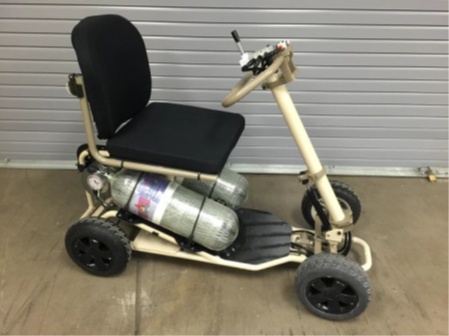

Pneumobility: Air Powered Mobility Devices
People who require powered mobility assistance have limited options for getting around. Currently, the best choice for many is an electric device with an expensive, slow-charging battery. To further complicate things, these devices are unusable in wet environments due to the electronics used to drive them, and as a result, users are restricted from participating in water-proximal activities – such as going to a pool, waterpark, or beach – and users must transfer out of the device in order to bathe or shower. PneuMobility devices are driven using only compressed air, which removes the need for electronics. Without batteries on board, PneuMobility devices weigh a fraction of electric powered devices, recharge in minutes, and no longer require expensive battery replacement. Not only could users save up to $500 per year, but it negates the hassle of proper environmentally-friendly battery disposal.

Description
The PneuMobility system consists of air tanks, air powered motors, air lines, and control valves. This air-powered design reduces maintenance; basic technical skills are all that’s necessary to troubleshoot a problem if one arises. The compressed air supply can be recharged an infinite number of times without losing performance, can be disposed of without any environmental concerns, and will not need to be replaced within the lifetime of the mobility device. While battery-powered devices can take up to eight hours to recharge, PneuMobility air tanks take only 10 minutes to refill, increasing users’ mobility, flexibility, and independence. These devices are even water-safe.Applications
• Home use, including showering• Recreation that involves getting wet (e.g., waterparks, public pools, beaches)
• Hospitals and nursing homes
• Airports
Advantages
• Lightweight• Waterproof
• Quick recharge time- minutes compared to hours
• Removes the need for expensive, environmentally hazardous